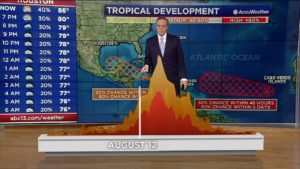The Future of TV Weather is Over The Top

The job of a broadcast meteorologist is changing, again. In addition to producing content for multiple live newscasts, the website, station apps, and social media, many weather teams are now producing OTT content.
OTT stands for “over the top” delivery systems like Roku and AppleTV. These platforms allow users to watch live broadcasts and play back prerecorded content on demand. And more people are doing it. Magid reports that 45% of OTT users stream local news through their connected TV.
New opportunities, new challenges
The Weather Company recently asked me to comment on the future of broadcast meteorology. I think OTT creates a significant opportunity for local TV stations and broadcast meteorologists to expand the weather and news coverage. It also creates a big challenge.
READ MORE: NEW STRATEGY: DIGITAL NOW INSTEAD OF DIGITAL FIRST
We know weather is the reason most people still watch local news. It can also be one of the reasons people consistently check a TV station’s streaming app. But the daily weather content uploaded to the server must stay relevant until the next update. I call this a Digital Now weather coverage strategy.
More than the daily forecast
OTT offers space to bolster a TV station’s weather coverage beyond the standard webcast. Live storm coverage, even with the weather is not severe, can provide valuable information to many viewers. Additionally, a library of pre-produced videos can keep them connected with the weather team, even when the weather is quiet.
 As you probably know, I am a big advocate for Max Reality. I believe it is the best story-telling tool available to broadcast meteorologists today. The software can be used to create dramatic long-form explanations. While these extended scenes might not fit within the time-constrained news broadcast, they can be customized to play forever on OTT platforms.
As you probably know, I am a big advocate for Max Reality. I believe it is the best story-telling tool available to broadcast meteorologists today. The software can be used to create dramatic long-form explanations. While these extended scenes might not fit within the time-constrained news broadcast, they can be customized to play forever on OTT platforms.
Work harder AND smarter
These are exciting times for local TV stations. We are genuinely broadcasting now, casting our message broadly across multiple platforms.
However, what works on TV doesn’t necessarily work on digital platforms. Screen sizes and viewing habits are different, not to mention the demographics of the user. Ideally, the weather content should be customized for each platform.
Managing all of this requires planning, coordination, and adjusting the daily workflow. Again.
Where do you see the future of TV weather going? I’d like to hear your thoughts. Email me: [email protected]
Tim Heller is an AMS Certified Broadcast Meteorologist, Talent Coach, and Weather Content Consultant. He helps local TV stations and broadcast meteorologists communicate more effectively on-air, online, and on social media.
Read more News & Insights from HellerWeather
